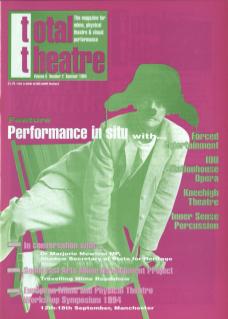IOU performs in a variety of spaces, not always conventional theatre spaces...Were your first shows outdoors?
DW: From the start it's always been a mixture of small-scale indoor shows and outdoor shows – both small-scale ones which can be set up in a couple of hours, and much larger scale shows.
Was the desire to work outside connected to wanting to establish an alternative audience relationship?
DW: Alternative to the indoor. We enjoy the difference and the surprise of working outdoors. With small-scale outdoor shows, which might happen in a park or at a festival, you can come across a different, unsuspecting audience. It's almost like ‘showing-what-we-do’ to a non-theatre audience and their reactions are very different. But we have never set out to make community based work. We make shows as tight as we can and present them to an audience.
I enjoy the accessibility of your work to a wide audience range. Is this important to the company?
DW: Yes. We don't set out with a particular audience in mind. We develop work for as many people as possible to watch and enjoy. We develop ideas from one show to another and it's the ideas which are accessible rather than targeting a particular audience group.
In your outdoor work has your relationship with your audience changed over the years?
DW: Not really. There's a conflict between holding an audience's attention and doing a 45 minute performance. A tension between pushing the work further and how to hold on to the audience.
One of the most exciting things about IOU is the object making and the integral function these objects have in the shows. How does the object making affect the process of devising your work?
DW: Most of the core members of IOU are painters and sculptors. Ideas always start from what something will look like, an object or an environment, and what someone wants to make. Someone has an idea of an object they want to make without really knowing how it will be used. The same applies to characters. It starts from a visual idea into which the performer feeds. The progression of the scenario is controlled by the object and the music. Dreaming of the ideas which fit into that happens at the same time, so that the narrative gradually reveals itself. We enjoy making. Quite often the performers on the stage have made the object they're working with. Some of the people we work with at the moment don't have making skills, but usually they have had to make the stuff they're dealing with in the show. The setting and the objects create an alternative world and the performers have to be at ease with these in order to make it believable and to carry off the illusion.
Have you ever made a show to suit a particular site, or does the limitation of touring prevent you from doing this?
DW: We've been doing site-specific shows right from the start. One of our first shows took place in a derelict house. The house sparked the activities for the show. We invented a life for the house and the audience watched from the garden. Boundary was originally made in The Studio, at the Alhambra, Bradford, and the ideas we developed for that show came from the space. We were going to do it only once but then decided to re-invent it and tour to a small number of middle-scale theatres. It's very interesting for us to work site-specifically outdoors, for us to reinvent space in the way we want to, to light a chunk of the outdoors in an interesting way, to choose bits of landscape and environment we don't normally pay attention to and to create an alternative world. The possibilities of working outdoors give us ideas to feed on, to play with scale, to mix what is real and what is being created. We did a show in a car park in Coventry, in which a car and caravan drove in – and the audience were wondering if it was supposed to happen or if it was an accident. Sometimes the audience becomes part of the action without knowing it.
How does the process of the indoor shows differ from those outdoors?
DW: They're all interconnected, the discoveries of one area feed the other. Small-scale outdoors is the most restrictive type of show because of external distractions. They have to be bolder than indoor shows in order to hold people’s attention. Indoors, attention can be focused down to a tiny dot. Use subtle music. Each type of location requires thinking in a particular way. Sometimes we might realise an outdoor element that we can bring indoors which we might not have happened upon or thought of without that area of work. The process is always similar, but the practicalities are different. All ideas simmer at a low level until circumstances and opportunities arise which might mean it happens in or outdoors depending on what suits the idea best at the time.
We never panic about not getting an idea into a show, because we know it will have its place sometime in some show if the idea is good.
What are your next planned projects?
DW: The Arts Centre, at the University of Warwick, has commissioned our next project Distance No Object, an indoor touring show, which will happen in October, with ten musicians and six performers. The music will lead the show as much as the visuals. And next summer we are making a new small-scale outdoor touring show Autoperipatetikos, with mechanical music, a mechanical horse and four performers.

